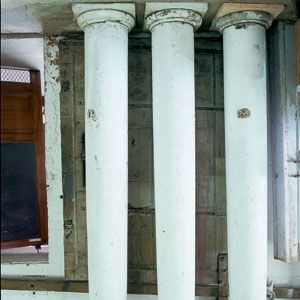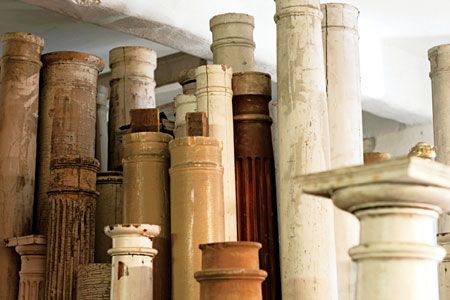Columns are important architectural pieces that have stood the test of time, tracing their roots back to ancient Greece and Rome. These structures provide crucial support while adding a touch of classic beauty to both indoor and outdoor spaces. Modern homeowners and designers are finding creative ways to incorporate salvaged columns into their spaces, blending historical charm with contemporary aesthetics.
Types of Columns
Columns can enhance a home’s style and structure, but your chosen column style can dramatically influence your space’s overall design and feel. From the intricate details of classical columns to the clean lines of modern designs and the natural charm of Craftsman or rustic styles, columns can be a great addition to your indoor or outdoor design. Understanding the different styles, their histories, and their materials can help you choose the right style for your home.
Classical Columns
Classical columns—in the Corinthian, Doric, and Ionic styles—are deeply rooted in ancient Greek and Roman architecture and have remained popular in traditional and colonial home designs. Here are three popular classical styles:
- Corinthian columns: Corinthian columns are the most decorative, characterized by elaborate capitals adorned with acanthus leaves. These columns exude luxury and are common in grand architectural designs.
- Doric columns: Doric columns are the simplest of the three, featuring a sturdy, plain design with no base and a fluted shaft. They are known for their strength and you’re likely to see them in more formal, stately structures.
- Ionic columns: Ionic columns are more slender and ornate. They’re recognizable by their scroll-like capitals, known as volutes. These columns add a touch of elegance while still maintaining a relatively simple profile.
Homeowners looking for a timeless, classical appearance often choose these styles to evoke a sense of history and elegance.
Modern Columns
In contrast to classical columns’ intricate details, modern columns embrace clean lines, minimalism, and functionality. These columns often use materials such as metal, fiberglass, or concrete for a sleek, simple look that complements contemporary home designs. Instead of featuring fluted shafts or ornate capitals, modern columns tend to be smooth, cylindrical, or rectangular.
Metal columns, especially those made from steel or aluminum, are common in modern architecture due to their slim profiles and ability to support significant loads without taking up too much space. Consider pairing them with large windows, flat roofs, and open floor plans for a light and airy feel. Modern columns are perfect for homeowners who prefer a minimalist look emphasizing simplicity and structure.
Craftsman or Rustic Columns
For a more grounded, natural style, Craftsman and rustic columns offer a simple, functional design that highlights the beauty of natural materials. These columns are typically square or rectangular with little to no ornate detailing and are often made from wood or stone. In Craftsman-style homes, columns tend to be short and stout, often tapering as they rise and sitting on stone or brick bases.
Rustic columns, on the other hand, tend to emphasize rugged materials like rough-hewn wood or fieldstone, blending the home with its natural surroundings. These columns provide a strong, sturdy look that complements cabins, lodges, and other rustic designs. The emphasis is on craftsmanship and natural materials, giving the home a cozy, inviting feel. Homeowners who prefer a more organic, handcrafted look will find Craftsman and rustic columns well-suited to their architectural style.
Column Materials
Columns are made from various materials, each offering distinct advantages in terms of appearance, strength, and maintenance. Popular column materials include the following:
- Fiberglass: Fiberglass is durable, low-maintenance, and resistant to moisture, rot, and pests. It can also mimic wood or stone.
- Metal (steel or aluminum): Metal is strong and sleek, though it may require rust protection. Designers often use metal in modern or industrial designs.
- PVC/vinyl: Lightweight, affordable, and easy to install, PVC is resistant to the elements but less durable than heavier materials. This material is a popular component of decorative columns.
- Stone: Stone is durable and elegant, making it suitable for formal architecture. However, stone is heavier and more expensive to install than other materials.
- Wood: Wood is traditional, versatile, and warm but requires regular maintenance to prevent rot, warping, and insect damage.
Matching Columns to Architectural Styles
Choosing the right columns to match your home’s architectural style will help ensure a cohesive design. Columns are not only structural elements but also key design features that can shape your home’s overall style and aesthetic. Different architectural styles call for specific types of columns, with variations in materials, shapes, and decorative details.
Traditional Architecture
Classical columns such as Corinthian, Doric, or Ionic are ideal for homes with traditional or colonial architecture. These columns feature intricate details, fluted shafts, and decorative capitals that reflect the grandeur of ancient Greek and Roman architecture. Here’s how traditional architecture might incorporate these classical columns:
- Greek Revival (1830–1860): Typically features Doric columns
- Neoclassical (late 19th to early 20th century): Often incorporates Ionic or Corinthian columns
- Colonial Revival (early to mid-20th century): May use a mix of column styles
In traditional settings, these columns often appear in porches, entryways, and large hallways, providing a stately and formal feel. Using wood or stone materials for these columns further enhances their historical elegance.
Modern and Contemporary Architecture
Modern and contemporary architecture favors sleek and minimalist columns. Clean lines, smooth finishes, and simple shapes define modern columns, which often use metal, fiberglass, or concrete. These columns complement the open floor plans and large windows typical in modern homes. Modern columns emphasize functionality and structure by avoiding excessive ornamentation and aligning with contemporary design’s minimalist and streamlined nature.
Craftsman and Rustic Architecture
For homes with a more organic or handcrafted design, such as Craftsman or rustic styles, square or rectangular columns made from natural materials like wood, brick, or stone are a perfect match. Craftsman homes, known for their emphasis on artisanal craftsmanship, often feature tapered columns with stone or brick bases, creating a sturdy yet inviting look. Rustic homes may incorporate rough-hewn wooden columns or stone pillars, which blend seamlessly with the natural environment and enhance the home’s warm, earthy feel.
Salvaged Columns: A New Life for Old Architecture

Salvaged columns give you a unique opportunity to incorporate a piece of history into modern spaces. These architectural elements, often rescued from demolished or remodeled buildings dating from the 1830s to the mid-20th century, bring character and charm to interior and exterior designs. These historical pieces can bring classical elegance and showstopping craftsmanship to your home that is hard to replicate with modern materials.
The Challenge of Exterior Use
While salvaged columns may seem ideal for outdoor use, they often require significant restoration due to years of exposure to the elements—and “because people tend not to maintain them,” says Reynold Lowe, the retired owner of Materials Unlimited, an architectural antique store in Ypsilanti, Michigan that closed in 2022. This makes exterior use challenging and often impractical for load-bearing applications. In addition to aesthetic considerations, you should evaluate structural integrity to ensure the columns you want to use are safe and durable.
Creative Interior Applications
Instead of limiting salvaged columns to traditional exterior roles, many homeowners and designers are finding innovative ways to use them indoors. Lowe suggests using porch columns in open-plan interiors to define activity zones without cordoning off floor space. This approach is particularly effective in loft spaces, where columns can add visual interest and architectural detail to otherwise stark environments.
In addition to defining spaces, salvaged columns can serve various interior functions, such as the following:
- Adding decorative flair to entryways or hallways
- Creating partitions between living and sleeping areas
- Flanking kitchen breakfast bars to separate food prep from dining areas
- Serving as table bases or display pedestals
- Supporting fireplace mantels
Selecting and Restoring Salvaged Columns
When choosing salvaged columns for your project, consider the following factors:
- Age: Older columns may have more historical value.
- Condition: Assess the level of restoration required.
- Design: Choose a style that complements your overall aesthetic.
- Size: Ensure the columns fit your space and intended use.
Restoring salvaged columns often involves the following steps:
- Removing layers of old paint
- Repairing or replacing damaged wood
- Treating for pests or rot
- Refinishing to protect and enhance the wood
Older paint layers may contain lead, so follow proper safety precautions during restoration. You may want to hire a professional to restore the columns to their former glory while adhering to safety standards.
The Value of Salvaged Columns
The cost of salvaged columns can vary widely, ranging from $100–$1,500 per column. How much a salvaged column might cost depends on the following factors:
- Age
- Condition
- Design complexity
- Historical significance
- Size
While the initial cost may seem high, the unique character and history these columns bring to a space can be invaluable. Many salvage dealers, including Lowe, offer expert advice on selection and installation as part of their service. Investing in these unique pieces often adds value to your property that mass-produced modern elements cannot replicate.
Exterior vs. Interior Columns
When it comes to columns, understanding the differences between interior and exterior columns is key to making the right choice for your home. Whether you’re adding support or beauty, columns serve different purposes depending on where you install them.
Exterior Columns
Exterior columns are all about strength and durability. They need to withstand the elements, including rain, wind, snow, and intense sunlight. That’s why you’ll often see materials like fiberglass, stone, or pressure-treated wood used outside. These materials are built to last, resisting rot, pests, and moisture.
And let’s not forget style—exterior columns are often the first thing people see when approaching your home. Whether you go for the classical grandeur of a Corinthian column or the clean lines of a modern metal post, exterior columns set the tone for your home’s overall look.
Interior Columns
Interior columns are typically more about aesthetics and creating visual interest inside your home, although they can also serve a structural role. Inside, you have more freedom with materials. While wood is still a popular option for its warmth and versatility, you can also use materials such as plaster or decorative stone veneer without worrying about exposure to the elements.
Interior columns can divide spaces (and eliminate the need for walls), add height to a room, or serve as a focal point with intricate designs. You’ll often see them in open-concept homes, where they subtly define spaces like living and dining areas.
Ultimately, exterior columns need to balance beauty with durability, while interior columns offer more flexibility while enhancing your home’s style and space. Choosing the right material and design for each will ensure your columns are both functional and a perfect fit for your home, inside and out.

